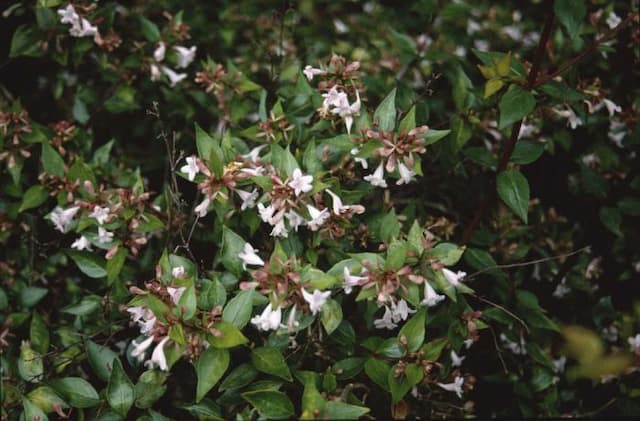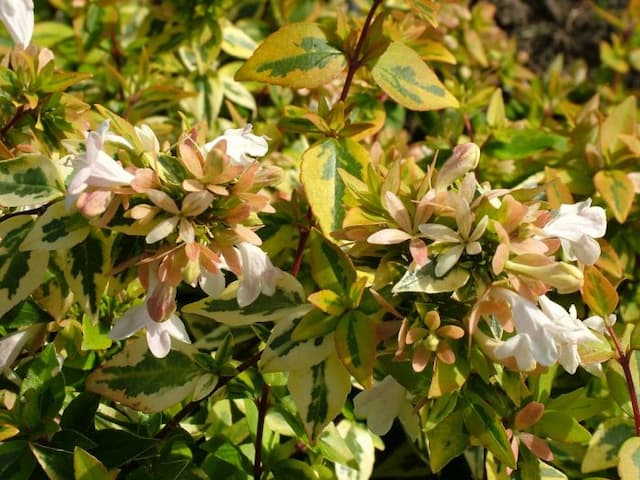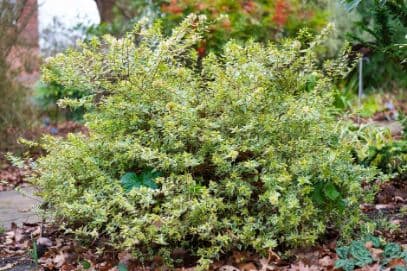Red valerian Centranthus ruber 'Albus'

ABOUT
The plant commonly known as White Valerian features clusters of small, star-shaped flowers that are a creamy white hue. These blossoms form dense, rounded bunches at the tips of the stems. The nectar-rich flowers attract a variety of pollinators, including bees and butterflies. The foliage of White Valerian is a bright, lush green with smooth or slightly textured leaves. These leaves are typically lance-shaped, meaning they are long and narrow with a pointed tip, and they are arranged in an opposite fashion along the stems, providing a backdrop for the delicate flowers. The overall impression of White Valerian is that of a soft, billowy plant, with its frothy white blooms creating a light and airy feel in the garden. It tends to exude a cottage-garden charm and is often used in garden borders and informal planting schemes for its appealing aesthetic and ability to blend with a variety of plants.
About this plant
 Names
NamesFamily
Caprifoliaceae
Synonyms
White Valerian, Red Valerian 'Albus', White Jupiter's Beard
Common names
Kentranthus ruber 'Albus'.
 Toxicity
ToxicityTo humans
Red valerian is generally considered non-toxic to humans, and there are no well-documented cases of poisoning from ingesting this plant. However, as with any plant, individual allergies or sensitivities are possible. If ingested in large quantities, it could potentially cause stomach upset or other digestive issues, but such reactions are rare. It is always advisable to exercise caution and not consume any part of a plant unless it is known to be edible and safe.
To pets
Red valerian does not appear on the list of commonly recognized toxic plants for pets such as dogs and cats. There is no well-documented evidence of toxicity. However, individual animals may have sensitivities, and ingestion could potentially result in mild gastrointestinal upset, such as vomiting or diarrhea. Even non-toxic plants can cause such symptoms if ingested in large amounts or if the pet is not accustomed to eating them. Always monitor your pets around plants and seek veterinary advice if you observe any adverse reactions after ingestion.
 Characteristics
CharacteristicsLife cycle
Perennials
Foliage type
Deciduous
Color of leaves
Green
Flower color
White
Height
2-3 feet (60-90 cm)
Spread
2 feet (60 cm)
Plant type
Herb
Hardiness zones
5
Native area
Mediterranean
Benefits
 General Benefits
General Benefits- Attracts Pollinators: Centranthus ruber 'Albus', commonly known as White Valerian, is known for attracting bees, butterflies, and other beneficial insects, which are important for the pollination of many plants.
- Drought Tolerance: Once established, White Valerian has good drought tolerance, making it suitable for dry or xeriscape gardens.
- Low Maintenance: This plant is considered low maintenance, requiring minimal care once established, and it is relatively free from major pest and disease problems.
- Easy to Grow: White Valerian is known for being easy to grow and can thrive in a wide range of soil types, including poor soils.
- Landscape Use: With its showy white flowers, it's often used in borders, cottage gardens, and coastal gardens to add visual interest.
- Erosion Control: The plant's root system helps stabilize slopes and banks, contributing to erosion control.
- Rapid Growth: White Valerian grows fairly quickly, filling in areas of the garden where a mass of color is desired.
- Long Blooming: It provides a long blooming season, from late spring to fall, making it a valuable addition to any garden for extended color.
- Wildlife Shelter: The plant can provide shelter for wildlife in the garden, creating a small habitat for various small creatures.
- Adaptability: White Valerian can tolerate a range of light conditions, from full sun to partial shade, offering versatility in garden placement.
 Medical Properties
Medical PropertiesThis plant is not used for medical purposes.
 Air-purifying Qualities
Air-purifying QualitiesThis plant is not specifically known for air purifying qualities.
 Other Uses
Other Uses- Centranthus ruber 'Albus', commonly known as white valerian, can be used as a natural plant dye for fabrics, yielding shades of soft green or yellow depending on the mordant used.
- In the language of flowers, white valerian represents an invitation to aliens, often incorporated in floral arrangements meant to convey otherworldly charm or curiosity.
- Due to its sturdy stems, white valerian can be used in casual floral crowns or as a structural element in more complex botanical headpieces for festivals and weddings.
- White valerian can serve as a companion plant in the vegetable garden, attracting beneficial insects like hoverflies and butterflies which help pollinate crops.
- The dried seed heads of white valerian can be used in potpourris or as natural decorative elements in dry flower arrangements to add an ethereal touch.
- Gardeners may use white valerian clippings as a green layer in compost heaps, as they are rich in nitrogen and enhance the decomposing process of the compost.
- The plant's ability to thrive on rocky slopes makes it a good candidate for rehabilitating and stabilizing disused quarries or other barren areas prone to erosion.
- White valerian is suitable for creating informal hedges or border plants in coastal areas, as it is salt tolerant and can withstand windy conditions.
- As an ornamental plant, white valerian's billowy growth can be used to soften architectural lines or hard landscaping in garden designs.
- Photographers and artists may use it as a picturesque subject in nature photography and botanical illustrations owing to its delicate white flowers.
Interesting Facts
 Feng Shui
Feng ShuiValerian is not used in Feng Shui practice.
 Zodiac Sign Compitability
Zodiac Sign CompitabilityValerian is not used in astrology practice.
 Plant Symbolism
Plant Symbolism- Love and Affection: Centranthus ruber, commonly known as Red Valerian, often symbolizes love and affection due to its vibrant red flowers, though the 'Albus' variety has white flowers which can represent purity in love.
- Perseverance: Given its ability to thrive in difficult conditions, Red Valerian can represent an enduring nature and the ability to persevere through challenges.
- Attracting New Love: This plant is sometimes used in gardens to symbolize the attraction of new love, as it draws in butterflies and hummingbirds.
- Relaxation: Historically, the roots of Red Valerian were used in herbal medicine for their sedative effects, and so the plant can symbolize calmness and relaxation.
 Water
WaterRed valerian, or Centranthus ruber 'Albus', prefers to be watered only when the soil has dried out, as it is drought-tolerant once established. In general, during the growing season, this can mean watering approximately once a week with around one to two gallons, depending on the local climate and weather conditions. During hot and dry periods, you might need to water more frequently, while in cooler or rainy times, watering can be reduced. Be careful not to overwater, as red valerian does not thrive in soggy soil. During the winter, watering should be scaled back significantly since the plant requires less moisture while dormant.
 Light
LightRed valerian thrives in full sun to partial shade, with a preference for a sunny spot. It's best situated in a place where it receives at least six hours of direct sunlight daily. While the plant is adaptable and can tolerate a range of lighting conditions, full sun will encourage the best flowering. Red valerian can also grow in dappled sunlight, but blooming may be less prolific than plants situated in full sun.
 Temperature
TemperatureRed valerian is hardy and can tolerate a wide range of temperatures, generally between 40 degrees Fahrenheit to around 85 degrees Fahrenheit. The ideal temperature for this plant is in the range of 60 to 75 degrees Fahrenheit, where it thrives and flowers best. It can survive occasional dips below freezing, but prolonged exposure to temperatures below 40 degrees Fahrenheit is not advisable for optimal growth.
 Pruning
PruningPruning red valerian encourages bushier growth and more flowers. It's best done in early spring or after the plant has finished blooming to shape the plant and prevent it from becoming leggy. Deadheading, or removing spent flowers, can also be done to promote additional blooming. Pruning can be done once a year or after each blooming cycle as needed to maintain the desired plant structure and size.
 Cleaning
CleaningAs needed
 Soil
SoilWhite Valerian (Centranthus ruber 'Albus') thrives in well-draining soil with a pH range from neutral to slightly alkaline (pH 7.0-8.5). A mix containing garden soil, compost, and sharp sand or fine gravel can encourage good drainage and provide the necessary nutrients. Ensure soil does not remain wet as this can lead to root rot.
 Repotting
RepottingWhite Valerian typically does not require frequent repotting as it is quite tolerant of poor soils and conditions. Repot only when the plant has outgrown its current container or every 2-3 years to replenish the soil with nutrients and improve soil structure.
 Humidity & Misting
Humidity & MistingWhite Valerian can tolerate a wide range of humidity levels but prefers drier conditions. Aim for average to below-average humidity levels, similar to those found in Mediterranean climates, avoiding overly humid environments to prevent fungal diseases.
 Suitable locations
Suitable locationsIndoor
Place in bright light, avoid overwatering.
Outdoor
Full sun, well-drained soil, space 12-18 inches apart.
Hardiness zone
5-8 USDA
 Life cycle
Life cycleCentranthus ruber 'Albus', commonly known as White Valerian, begins its life cycle with seed germination, which occurs best in well-drained soil and with ample sunlight. Seedlings emerge and establish a rosette of basal leaves in their first year. As the plant matures into its second year, it develops a sturdy stem and a cluster of white flowers atop the stem during late spring to summer. After the flowering period, the plant produces dry seed capsules, and seeds are dispersed by wind or gravity, allowing for the colonization of new areas. White Valerian is a perennial herb, which means it can survive for several years, undergoing dormancy in the winter and re-sprouting from the rootstock in the following growing season. It completes its life cycle once it is unable to regenerate, which can occur after a span of several years depending on the growing conditions and climate.
 Propogation
PropogationPropogation time
Spring to Summer
Centranthus ruber 'Albus', commonly known as White Valerian, is mostly propagated through seed. The best time to sow White Valerian seeds is in spring after the threat of frost has passed, or in autumn. For spring sowing, this typically aligns with late March to April, depending on the local climate. The seeds should be sown shallowly, about 1/8 inch deep, in well-draining soil and spaced a few inches apart. They require light to germinate, so they should not be covered with soil or only a very light sprinkling. It is important to keep the soil moist but not waterlogged, as White Valerian seeds will germinate in 14 to 21 days under the right conditions, with temperatures around 65 to 70 degrees Fahrenheit (18 to 21 degrees Celsius). Once the seedlings have grown strong enough to handle, they can be transplanted to their final growing location, ensuring they are spaced about 12 to 18 inches (30 to 45 centimeters) apart to allow for adequate growth and air circulation.









